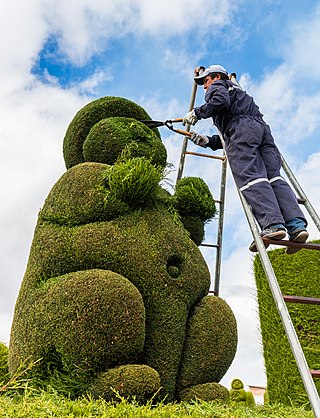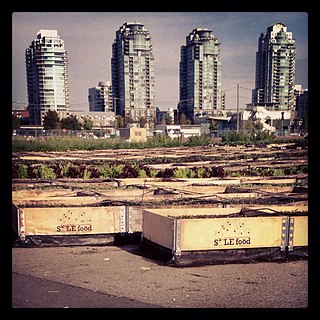
Gardening is the practice of growing and cultivating plants as part of horticulture. In gardens, ornamental plants are often grown for their flowers, foliage, or overall appearance; useful plants, such as root vegetables, leaf vegetables, fruits, and herbs, are grown for consumption, for use as dyes, or for medicinal or cosmetic use.

Agritourism or agrotourism involves any agriculturally based operation or activity that brings visitors to a farm or ranch.

In urban planning, zoning is a method in which a municipality or other tier of government divides land into "zones", each of which has a set of regulations for new development that differs from other zones. Zones may be defined for a single use, they may combine several compatible activities by use, or in the case of form-based zoning, the differing regulations may govern the density, size and shape of allowed buildings whatever their use. The planning rules for each zone determine whether planning permission for a given development may be granted. Zoning may specify a variety of outright and conditional uses of land. It may indicate the size and dimensions of lots that land may be subdivided into, or the form and scale of buildings. These guidelines are set in order to guide urban growth and development.

Urban agriculture refers to various practices of cultivating, processing, and distributing food in urban areas. The term also applies to the area activities of animal husbandry, aquaculture, beekeeping, and horticulture in an urban context. Urban agriculture is distinguished from peri-urban agriculture, which takes place in rural areas at the edge of suburbs.

Redevelopment is any new construction on a site that has pre-existing uses. It represents a process of land development uses to revitalize the physical, economic and social fabric of urban space.

Guerrilla gardening is the act of gardening – raising food, plants, or flowers – on land that the gardeners do not have the legal rights to cultivate, such as abandoned sites, areas that are not being cared for, or private property. It encompasses a diverse range of people and motivations, ranging from gardeners who spill over their legal boundaries to gardeners with a political purpose, who seek to provoke change by using guerrilla gardening as a form of protest or direct action. This practice has implications for land rights and land reform; aiming to promote re-consideration of land ownership in order to assign a new purpose or reclaim land that is perceived to be in neglect or misused. Some gardeners work at night, in relative secrecy, in an effort to make the area more useful or attractive, while others garden during the day for publicity.
Rancho Mission Viejo is an active 23,000 acres (9,300 ha) ranch and farm, habitat reserve, residential community, and census-designated place in South Orange County, California. Rancho Mission Viejo originated as a series of land grants to John Forster in 1845. The remaining part of Rancho Mission Viejo consists of a nearly 17,000-acre (6,900 ha) nature reserve and multiple residential communities slated to open in phases between 2010 and 2030. As of the 2020 census, it had a population of 10,378.

A community garden is a piece of land gardened or cultivated by a group of people individually or collectively. Normally in community gardens, the land is divided into individual plots. Each individual gardener is responsible for their own plot and the yielding or the production of which belongs to the individual. In collective gardens the piece of land is not divided. A group of people cultivate it together and the harvest belongs to all participants. Around the world, community gardens exist in various forms, it can be located in the proximity of neighborhoods or on balconies and rooftops. Its size can vary greatly from one to another.

The South Central Farm, also known as the South Central Community Garden, was an urban farm and community garden located at East 41st and South Alameda Streets, in an industrial area of South Los Angeles, California, which was in operation between 1994 and 2006. At 14 acres (5.7 ha), it was considered one of the largest urban farms in the United States. The farm was sold in 2004, and the farmers were evicted in 2006. On July 5, 2006, workers began bulldozing the farm amidst strong protest and acts of civil disobedience. The farmers disputed the validity of the sale in court and staged vigils in protest. The farm is the subject of the 2008 Academy Award-nominated documentary film The Garden and the PBS documentary, South Central Farm, Oasis in a Concrete Desert.

Conservation development, also known as conservation design, is a controlled-growth land use development that adopts the principle for allowing limited sustainable development while protecting the area's natural environmental features in perpetuity, including preserving open space landscape and vista, protecting farmland or natural habitats for wildlife, and maintaining the character of rural communities. A conservation development is usually defined as a project that dedicates a minimum of 50 percent of the total development parcel as open space. The management and ownership of the land are often formed by the partnership between private land owners, land-use conservation organizations and local government. It is a growing trend in many parts of the country, particularly in the Western United States. In the Eastern United States, conservation design has been promoted by some state and local governments as a technique to help preserve water quality.

Urban horticulture is the science and study of the growing plants in an urban environment. It focuses on the functional use of horticulture so as to maintain and improve the surrounding urban area. Urban horticulture has seen an increase in attention with the global trend of urbanization and works to study the harvest, aesthetic, architectural, recreational and psychological purposes and effects of plants in urban environments.
Development-supported agriculture is a nascent movement in real estate development that preserves and invests in agricultural land use. As farmland is lost due to the challenging economics of farming and the pressures of the real estate industry, DSA attempts to reconcile the need for development with the need to preserve agricultural land. The overall goal of DSA is to incubate small-scale organic farms that co-exist with residential land development, providing benefits to farmers, residents, the local community, and the environment.
Urban homesteading can refer to several different things: programs by local, state, and federal agencies in the USA who work to help get people into city homes, squatting, practicing urban agriculture, or practicing sustainable living techniques.

Community gardens in the United States benefit both gardeners and society at large. Community gardens provide fresh produce to gardeners and their friends and neighbors. They provide a place of connection to nature and to other people. In a wider sense, community gardens provide green space, a habitat for insects and animals, sites for gardening education, and beautification of the local area. Community gardens provide access to land to those who otherwise could not have a garden, such as apartment-dwellers, the elderly, and the homeless. Many gardens resemble European allotment gardens, with plots or boxes where individuals and families can grow vegetables and flowers, including a number which began as victory gardens during World War II. Other gardens are worked as community farms with no individual plots at all, similar to urban farms.

Agritopia is a 166-acre mixed use planned community in Gilbert, Arizona designed to encourage agrarianism combined with a sense of community among the socioeconomic ranges. It is an agrihood with housing plots, a certified organic farm, and commercial spaces. Homes range from 1300 square feet to 7000 square feet. Narrow streets and front porches, with low back fences, encourage neighborly socialization.

Sole Food Street Farms is an urban agriculture project in Vancouver, British Columbia, Canada. Founded in 2008 by Michael Ableman and Seann Dory, Sole Food's mission is to provide low-income residents of the Downtown Eastside with "jobs, agricultural training, and inclusion in a supportive community of farmers and food lovers." It is a subsidiary of Cultivate Canada, a local charity that promotes human ecology-related social projects. Sole Food is the largest urban farm attempted in Vancouver, and through it Ableman hopes to demonstrate that "urban agriculture can in fact be considered a serious enterprise for urban areas." He emphasizes that it is of a larger scale than community gardens and that it could be a "serious enterprise for urban areas." Since its inception, Sole Food has been met with significant community support. Grants from a variety of sources including the city of Vancouver, banks, as well as philanthropists enable Sole Food to continue expanding their operations. Sole Food's vision aligns closely with Vancouver’s Greenest City 2020 Action plan to increase production of locally grown food, hence the city has provided them with generous support. Being a non-profit social initiative, priority is placed upon improving the community: employees, many of whom are current or recovering drug addicts receive paid training, and 10% of the produce harvested is donated to neighbourhood agencies. Due to the small scale of Sole Food and the use of high-quality seeds, the food produced is relatively expensive compared to conventionally grown crops. As such, the food grown does not go toward feeding impoverished residents of the Downtown Eastside, but rather to a number of upscale restaurants that specialize in locally sourced ingredients. The produce is sold to 30 restaurants in Vancouver that specialize in using locally-sourced ingredients. It also sells to seven local farmers’ markets.
The Food Justice Movement is a grassroots initiative which emerged in response to food insecurity and economic pressures that prevent access to healthy, nutritious, and culturally appropriate foods. It includes more broad policy movements, such as the Food and Agricultural Organization of the United Nations.
Keep Growing Detroit is an organization dedicated to food sovereignty and community engagement in the cities of Detroit, Hamtramck, and Highland Park. Founded in 2013, the program designs and implements initiatives that promote the practice of urban agriculture as a mode of food justice for underrepresented communities, particularly those who do not have access to healthy food options. The goals of Keep Growing Detroit are to educate and empower community members using urban agricultural practices. Programs such as the Garden Resource Program and Grown in Detroit served as catalysts, laying the foundation for Keep Growing Detroit.
Community gardens in New York City are urban green spaces created and cared for by city residents who steward the often underutilized land. There are over 550 community gardens on city property, over 745 school gardens, over 100 gardens in land trusts, and over 700 gardens at public housing developments throughout New York City. The community garden movement in NYC began in the Lower East Side during the disrepair of the 1960s on vacant, unused land. These first gardens were tended without governmental permission or assistance.
Urban agriculture is the practice of cultivating, processing, and distributing food in or around urban areas. It is the growing of fresh produce within the city for individual, communal, or commercial purposes in cities in both developed and developing countries.













